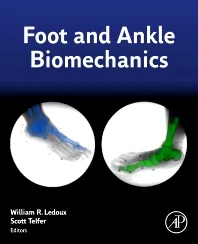
Foot and Ankle Biomechanics is edited by William Ledoux & Scott Telfer and is the one source, comprehensive and modern reference regarding foot and ankle biomechanics. This text serves as both a master reference for foot biomechanics, presenting a clear state of the research and capabilities in the field. The customers for this book will be those looking for information on foot and ankle biomechanics for a range of applications; for example, designers of orthotics.
Features:
Provides a comprehensive overview of the science of foot and ankle biomechanics that is presented in an easily accessible format
Presents normative data and descriptions relating to the structure and function of the foot and ankle, along with comparisons to pathological conditions
Includes multimedia content to support modeling and simulation chapters
Foot and Ankle Biomechanics comprehensively covers the anatomy, measurement and function of the foot and ankle in the normative, pathologic and clinically treated states. The text begins with anatomy, anatomical nomenclature, the kinematics and kinetics of common tasks, and a typical clinical examination and measurement. The next section describes the current methods of measuring, analysing, modelling and predicting foot and ankle biomechanics. These include imaging modalities, research-specific measurement technologies, and research tools which are at the forefront of predictive modelling. Following this, the text explores common musculoskeletal pathologies including those typical in early life, those acquired due to injury, disease or overuse, and pathologies associated with age. The concluding sections of this reference focus on clinical treatment, both conservative and surgical such as: joint fusion and replacement, fracture fixation, reconstruction and more. Each of the sections of this text describes the state of research and clinical practice, and the long term implications of the pathology/treatment to the biomechanics of the foot and ankle.
The purpose of this book is to include in one source, a comprehensive and modern reference regarding foot and ankle biomechanics. While other texts focus on diagnosis, specific injuries, anatomy or surgical technique, this text seeks a synergy of all such elements. This text therefore serves as both a master reference for foot biomechanics and to present a clear state of the research and capabilities in this field to the reader – if you are new to the topic or already an expert in it. This book provides an overall state of the fields understanding about biomechanics in one reference. The book also links together its individual sections, providing you with a clear path between particular pathologies, how they are treated, and how their impact on biomechanics can be measured. This book serves as a resource to bridge the gap between clinical practice and state-of-the-art bioengineering research, and thus serves as a reference for both communities.








